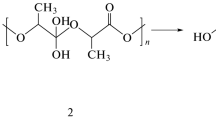Abstract
This work assessed biodegradation, by Aspergillus, Fusarium, Penicillium and Parengyodontium fungi, of four samples of poly-ε-caprolactone (PCL), three samples of poly-l-lactide (PLA) and one sample of poly-d,l-lactide (DL-PLA) produced by ring-opening polymerization initiated by aluminium complexes of corresponding lactones. Mesophilic fungal strains actively biodegrading PCL (F. solani) and PLA (Parengyodontium album and A. calidoustus) were selected. The rate of degradation by the selected fungi was found to depend on the physicochemical and mechanical properties of the polymers (molecular weight, polydispersity, crystallinity). The most degradable poly-ε-caprolactone sample was shown to have the lowest molecular weight; the most biodegradable polylactide DL-PLA had the lowest crystallinity. Mass spectral analysis of biodegraded polymer residues showed PCL to be degraded more intensively than PLA. It is established that in the case of Parengyodontium album the colonization of the films of polypropylene composites with DL-PLA is observed, which will undoubtedly contribute to their further destruction under the influence of abiotic factors in the environment.






Similar content being viewed by others
References
Platel RH, Hodgson LM, Williams CK (2008) Biocompatible initiators for lactide polymerization. Polym Rev 48:11–63
Stanford MJ, Dove AP (2010) Stereocontrolled ring-opening polymerisation of lactide. Chem Soc Rev 39:486–494
Slomkowski S, Penczek S, Duda A (2014) Polylactides—an overview. Polym Adv Technol 25:436–447
Kamber NE, Jeong W, Waymouth RM, Pratt RC, Lohmeijer BG, Hedrick JL (2007) Organocatalytic ring-opening polymerization. Chem Rev 107:5813–5840
Dechy-Cabaret O, Martin-Vaca B, Bourissou D (2004) Controlled ring-opening polymerization of lactide and glycolide. Chem Rev 104:6147–6176
Wu J, Yu TL, Chen CT, Lin CC (2006) Recent developments in main group metal complexes catalyzed/initiated polymerization of lactides and related cyclic esters. Coord Chem Rev 250:602–626
Тokiwa Y, Calabia BP, Ugwu ChU, Aiba S (2009) Biodegradability of plastics. Int J Mol Sci 10:3722–3742
Suyama T, Tokiwa Y, Oichanpagdee P, Kanagawa T, Kamagata Y (1998) Phylogenetic affiliation of soil bacteria that degrade aliphatic polyesters available commercially as biodegradable plastics. Appl Environ Microbiol 64:5008–5011
Kim DJ, Rhee YH (2003) Biodegradation of microbial and synthetic polyesters by fungi. Appl Microbiol Biotechnol 61:300–308
Tokiwa Y, Jarerat A (2004) Biodegradation of poly(L-lactide). Biotechnol Lett 26:771–777
Jarerat A, Tokiwa Y, Tanaka H (2003) Poly(L-lactide) degradation by Kibdelosporangium aridum. Biotechnol Lett 25:2035–2038
Jarerat A, Tokiwa Y (2001) Degradation of poly(L-lactide) by a fungus. Macromol Biosci 1:136–140
Saadi Z, Rasmont А, Cesar G, Bewa H, Benguigui L (2012) Fungal degradation of poly(L-lactide) in soil and in compost. J Polym Environ 20:273–282
Torres A, Li SM, Roussos S, Vert M (1996) Screening of microorganisms for biodegradation of poly(lactic acid) and lactic acid-containing polymers. Appl Environ Microbiol 62:2393–2397
Khan MR, Arshad M, Raza SA (2012) Biodegradation of synthetic polymers by fungi. Asian J Chem 24:4583–4586
Karamanlioglu M, Houlden A, Robson GD (2014) Isolation and characterisation of fungal communities associated with degradation and growth on the surface of poly(lactic) acid (PLA) in soil and compost. Int Biodeterior Biodegrad 95:301–310
Kireenko MM, Kuchuk EA, Zaitsev KV, Tafeenko VA, Oprunenko YF, Churakov AV, Lermontova EKh, Zaitseva GS, Karlov SS (2015) Aluminum complexes based on pyridine substituted alcohols: synthesis, structure, and catalytic application in ROP. Dalton Trans 44:11963–11976
Zaitsev KV, Kuchuk EA, Mankaev BN, Churakov AV, Zaitseva GS, Lemenovskii DA, Karlov SS (2014) Synthesis, structure, and catalytic activity of new aluminum complexes formed with sterically bulky ligands. Russ Chem Bull 63:2630–2634
Piscun YA, Vasilenko IV, Zaitsev KV, Oprunenko YF, Kostjuk SV (2017) Synthesis of functional poly(ε-caprolactone)s via living ring-opening polymerization of ε-caprolactone using functionalized aluminum alkoxides as initiators. Macromol Chem Phys 218:1600580
Kuchuk EA, Zaitsev KV, Mamedova FA, Churakov AV, Zaitseva GS, Lemenovsky DA, Karlov SS (2016) Synthesis, structure, and catalytic activity of new aluminum and titanium complexes based on aminobisphenolate ligands containing bulky substituents. Russ Chem Bull 65:1743–1749
Zaitsev KV, Piscun YA, Oprunenko YF, Karlov SS, Zaitseva GS, Vasilenko IV, Churakov AV, Kostjuk SV (2014) Controlled ring-opening homo- and copolymerization of ε-caprolactone and d,l-lactide by iminophenolate aluminum complexes: an efficient approach toward well-defined macromonomers. J Polym Sci A 52:1237–1250
Aladyshev AM, Isichenko ОR, Nedorezova PM, Tsvetkova VI, Gavrilov Y, Dyachkovskii FS (1991) Features of polymerization of propylene in mass on a titanium-magnesium catalyst in the presence of hydrogen. Vysokomol Soedin Ser A 33:1708–1717 (in Russian)
Nedorezova PM, Aladyshev AM, Savinov DV, Veksler EN, Tsvetkova VI, Lemenovskii DA (2003) Isospecific bulk polymerization of propylene with the use of ansa-metallocenes as a mixture of rac and meso isomers. Kinet Catal 44:311–318
Kissin YuV (1985) Isospecific polymerization of olefins. Springer, New York
Bilay VI (ed) (1982) Methods of experimental mycology. Naukova Dumka, Kiev (in Russian)
Tokiwa Y, Ando T, Suzuki T (1976) Degradation of polycaprolactone by a fungus. J Ferment Technol 54:603–608
Benedict CV, Cook WJ, Jarrett P, Cameron JA, Huang SJ, Bell JP (1983) Fungal degradation of polycaprolactones. J Appl Polym Sci 28:327–334
Alexandrova AV, Sidorova II, Tiunov AV (2011) Microfungi of soils and litter of the National Park Cat Tien (South Vietnam). Mikolog I Fitopatolog 45:12–25 (in Russian)
Tokiwa Y, Suzuki T (1978) Hydrolysis of polyesters by Rhizopus delemar lipase. Agric Biol Chem 42:1071–1072
Liu P, Ouyang Y, Xiao R (2012) Fabrication and morphology development of isotactic polypropylene nanofibers from isotactic polypropylene/polylactide blends. Appl Polym 123:2859–2866
Acknowledgements
We thank Dr. V.A. Korolkov (N.D. Zelinsky Institute of Organic Chemistry RAS, Moscow, Russia) for mass-spectral data. This work was supported partially by M.V. Lomonosov Moscow State University Program of Development and G.K. Skryabin Institute of Biochemistry and Physiology of Microorganisms RAS.
Author information
Authors and Affiliations
Corresponding author
Rights and permissions
About this article
Cite this article
Antipova, T.V., Zhelifonova, V.P., Zaitsev, K.V. et al. Biodegradation of Poly-ε-caprolactones and Poly-l-lactides by Fungi. J Polym Environ 26, 4350–4359 (2018). https://doi.org/10.1007/s10924-018-1307-3
Published:
Issue Date:
DOI: https://doi.org/10.1007/s10924-018-1307-3




